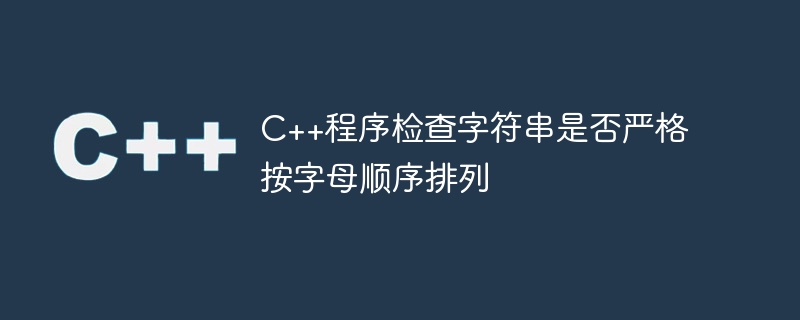
假设我们有一个包含 n 个小写字母的字符串 S。如果字符串遵循以下规则,则它是严格的字母字符串 -
将空字符串写入 T
在第i步,取出拉丁字母表中的第i个小写字母,并将其插入到 字符串 T 的左侧或字符串 T 的右侧(c 是拉丁字母表中的第 i 个字母)。
我们必须检查 S 是否严格是否按字母字符串排列。
要解决这个问题,我们需要操作字符串。编程语言中的字符串是 存储在特定的类似数组的数据类型中的字符流。多种语言 将字符串指定为特定数据类型(例如 Java、C++、Python);和其他几种语言 将字符串指定为字符数组(例如 C)。字符串在编程中很有用,因为它们 通常是各种应用程序中的首选数据类型,并用作输入的数据类型 和输出。有各种字符串操作,例如字符串搜索、子字符串生成、 字符串剥离操作、字符串翻译操作、字符串替换操作、字符串 反向操作等等。查看下面的链接以了解字符串如何 用于 C/C++ 中。
https://www.tutorialspoint.com/cplusplus/cpp_strings.htm
https://www.tutorialspoint.com/cprogramming/c_strings。 htm
因此,如果我们问题的输入类似于 S = "ihfcbadeg",那么输出将为 True。
要解决这个问题,我们将遵循以下步骤 -
len := size of S
for initialize i := len, when i >= 1, update (decrease i by 1), do:
if S[l] is the i th character, then:
(increase l by 1)
otherwise when S[r] is the ith character, then:
(decrease r by 1)
Otherwise
Come out from the loop
if i is same as 0, then:
return true
Otherwise
return false让我们看看以下实现,以便更好地理解 -
#include <bits/stdc++.h>
using namespace std;
bool solve(string S){
int len = S.size(), l = 0, r = len - 1, i;
for (i = len; i >= 1; i--){
if (S[l] - 'a' + 1 == i)
l++;
else if (S[r] - 'a' + 1 == i)
r--;
else
break;
}
if (i == 0)
return true;
else
return false;
}
int main(){
string S = "ihfcbadeg";
cout << solve(S) << endl;
}"ihfcbadeg"
1
以上是C++程序检查字符串是否严格按字母顺序排列的详细内容。更多信息请关注PHP中文网其他相关文章!




